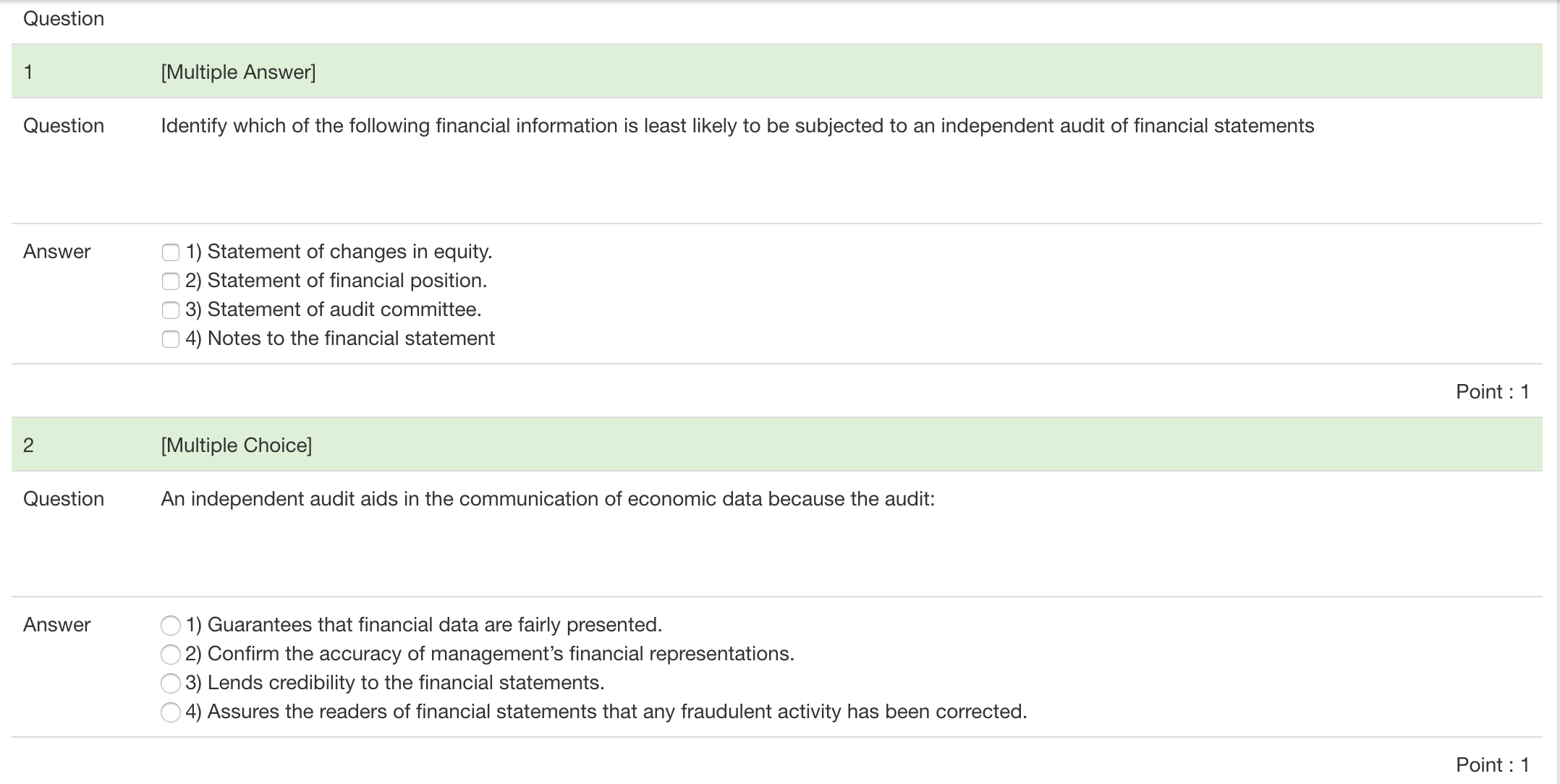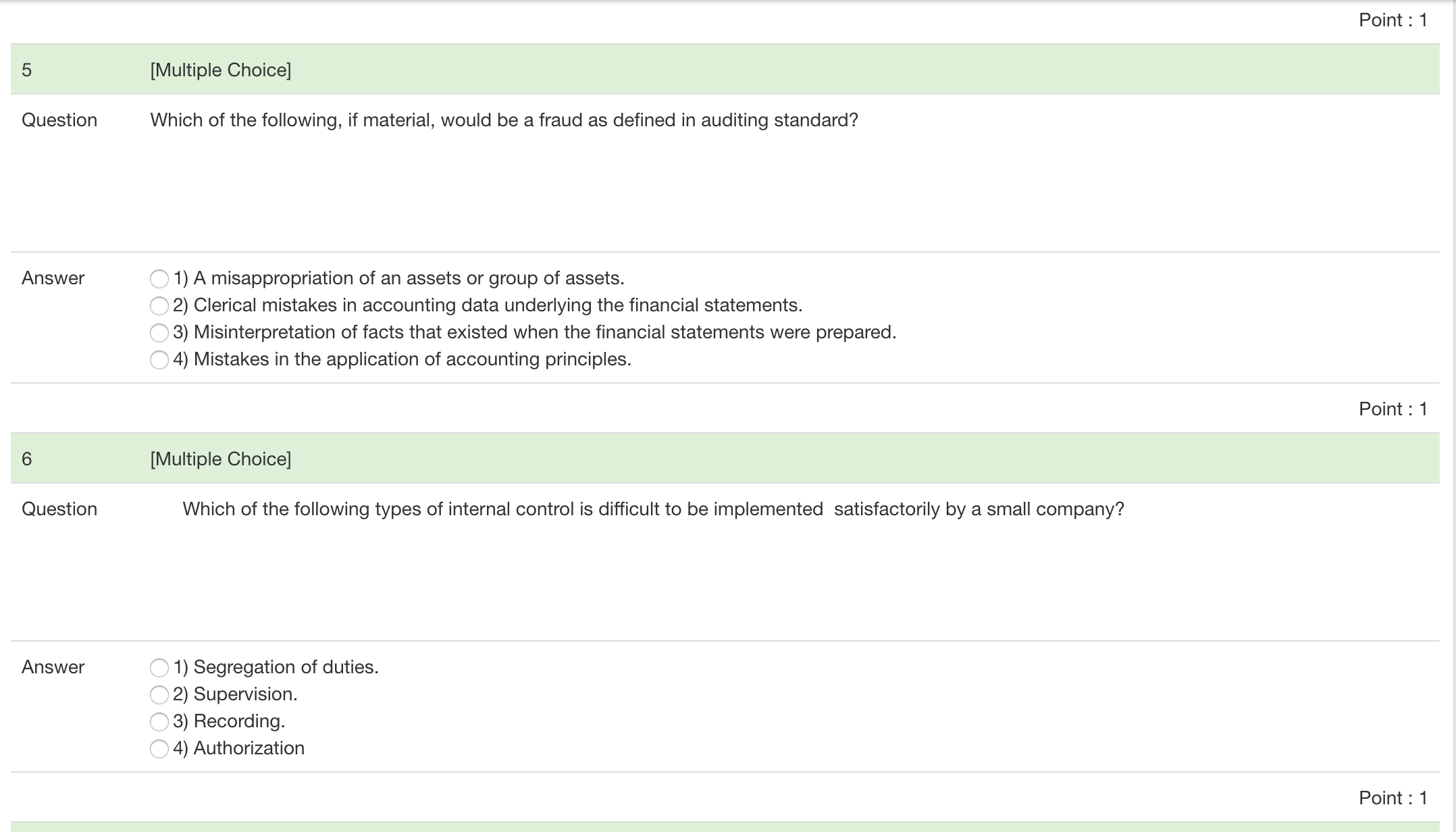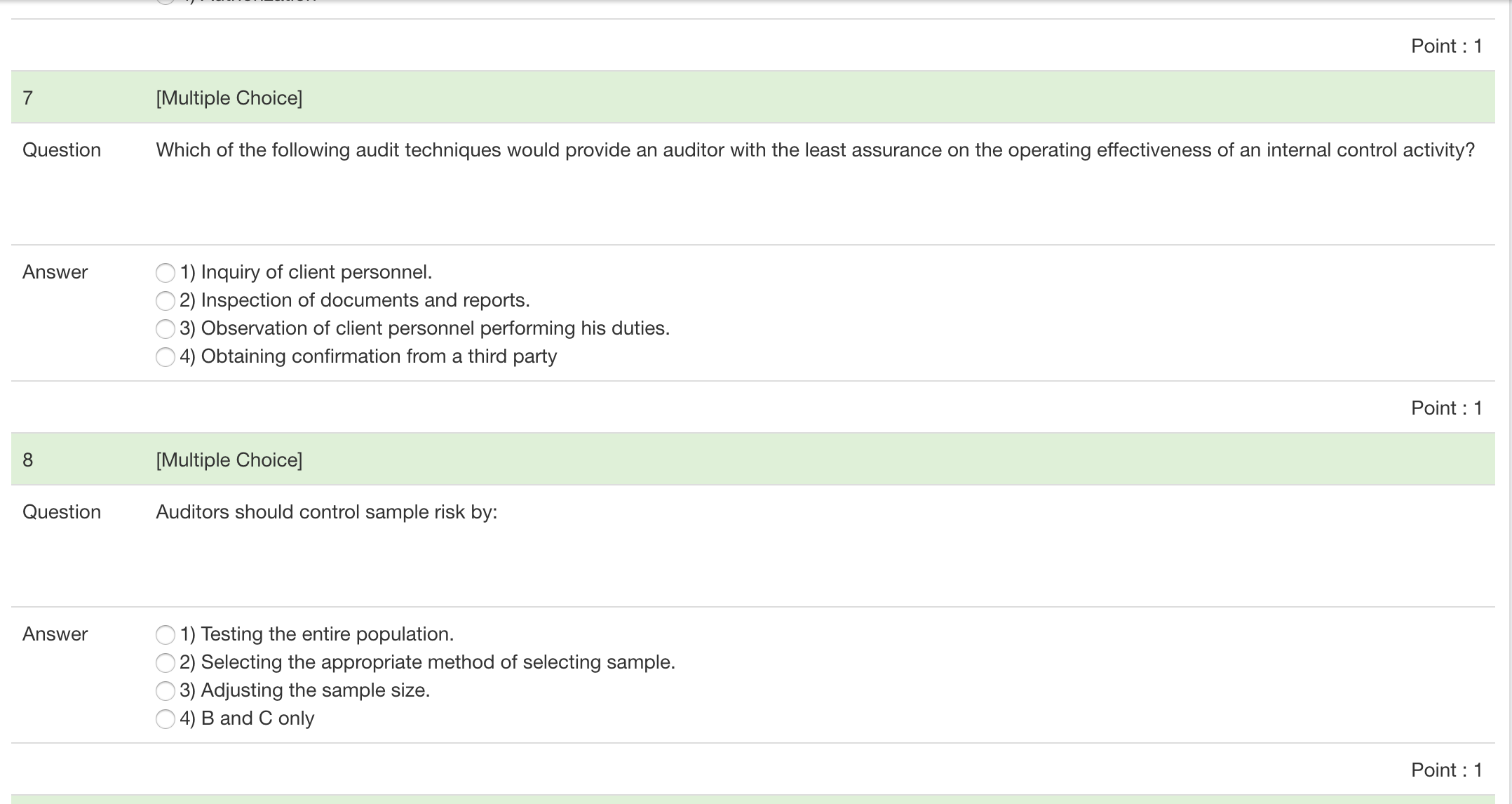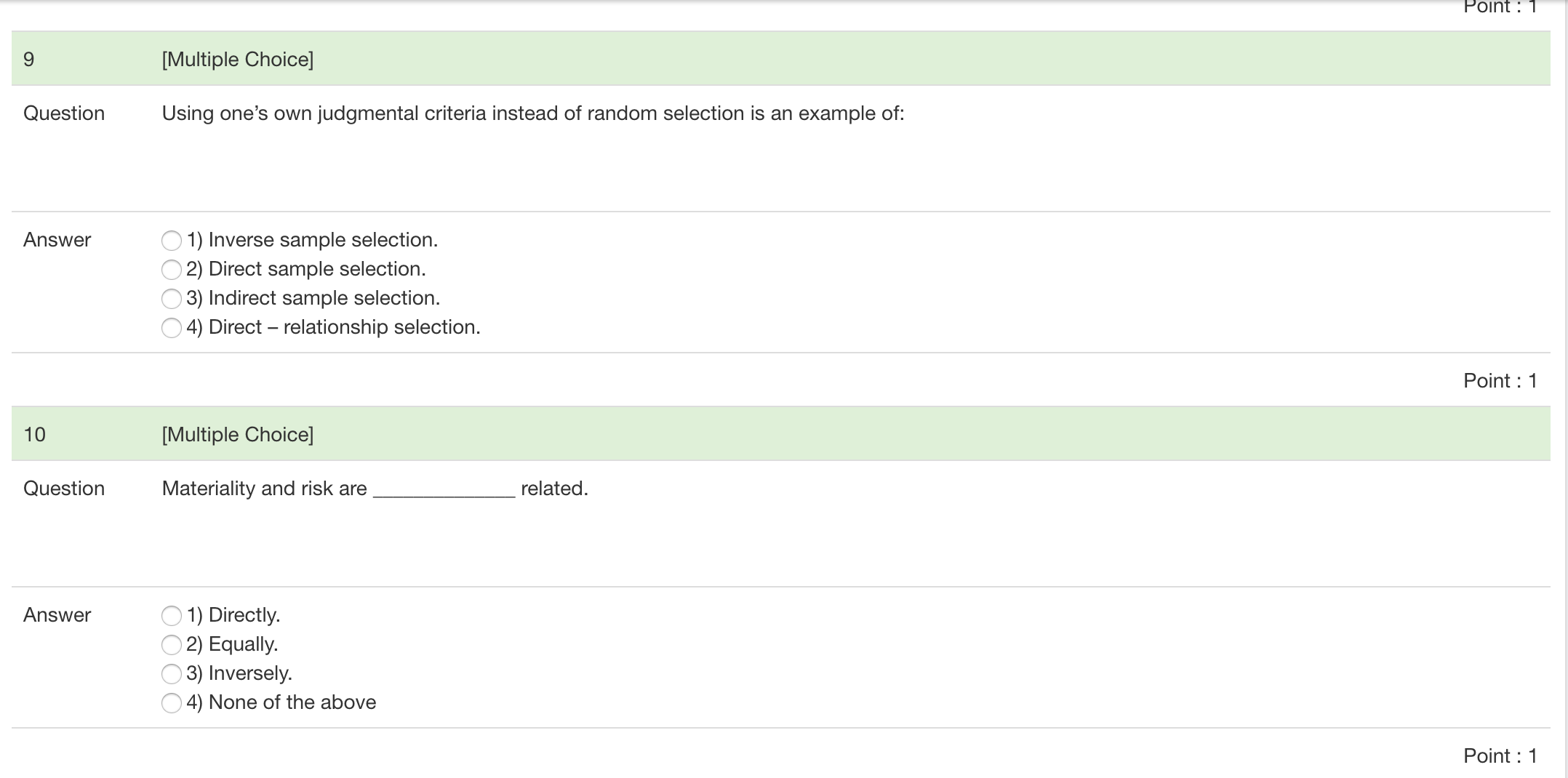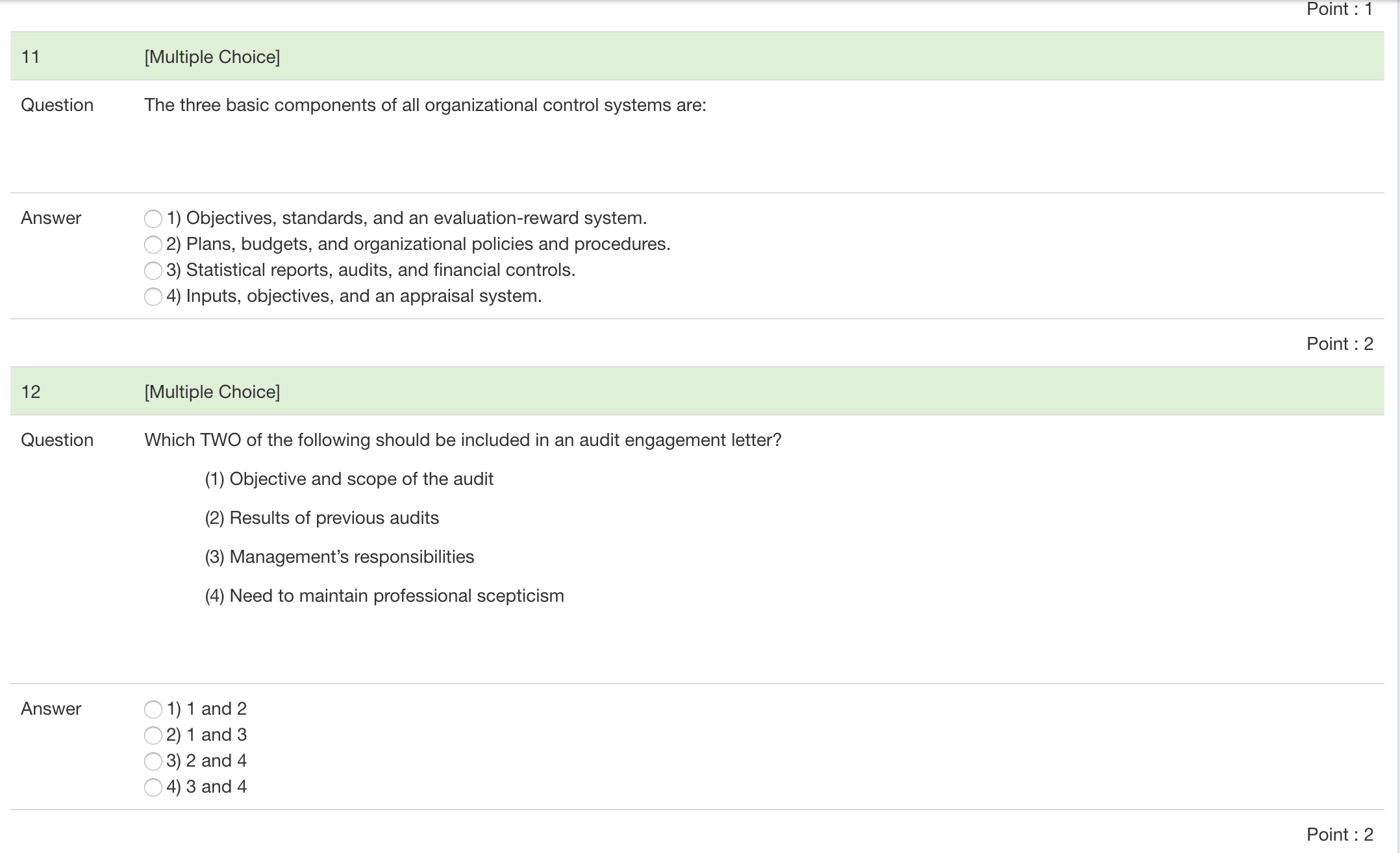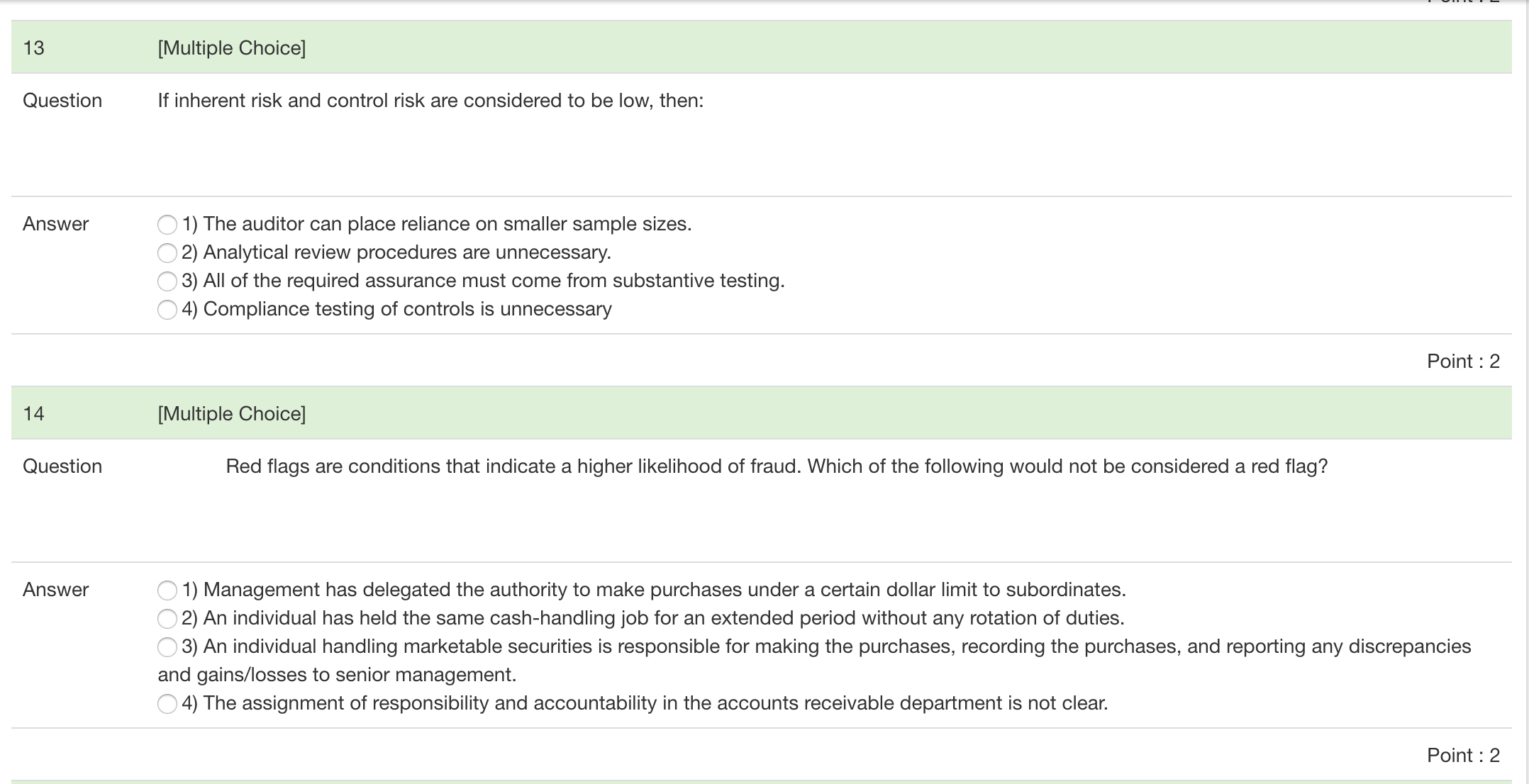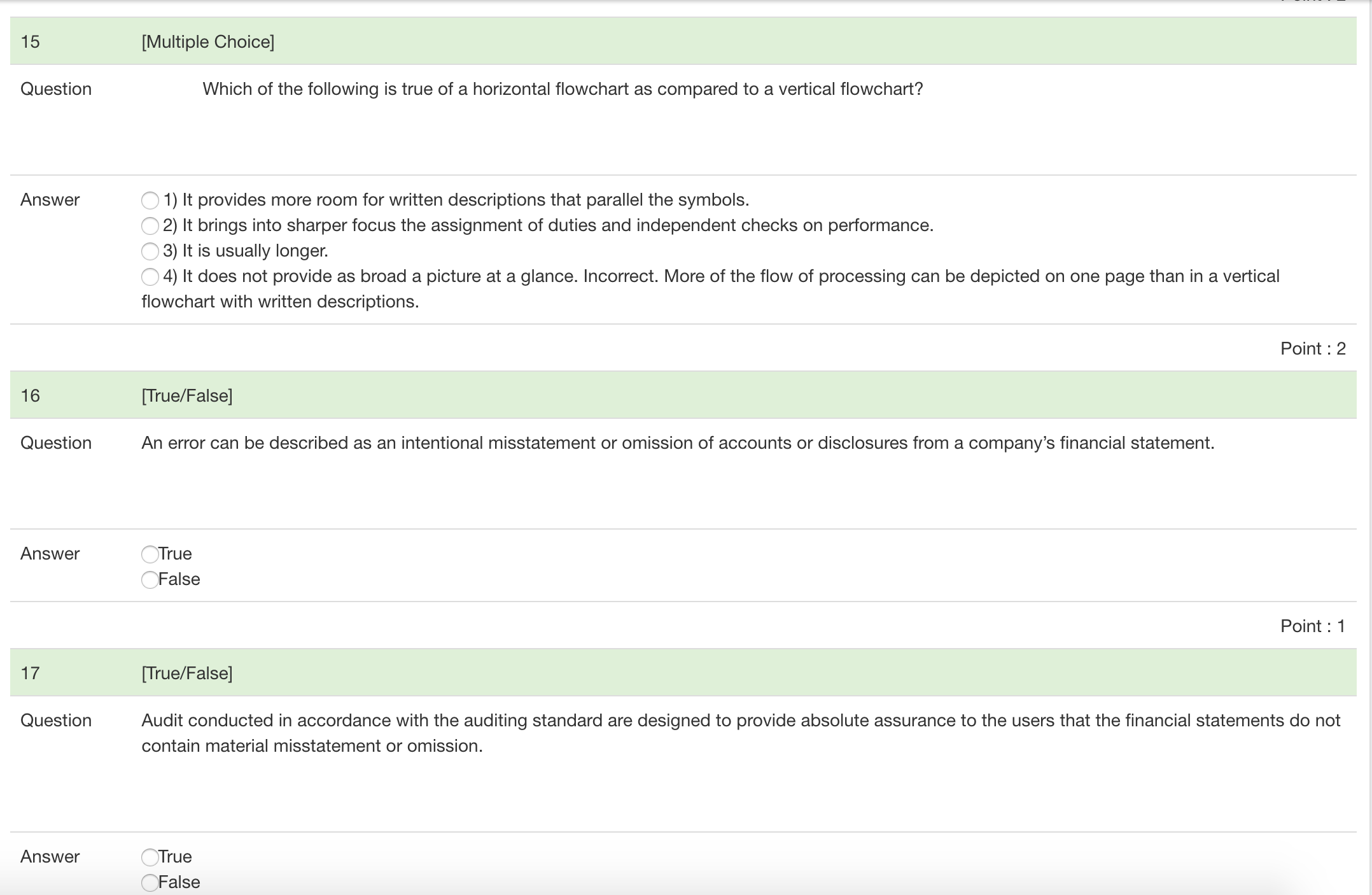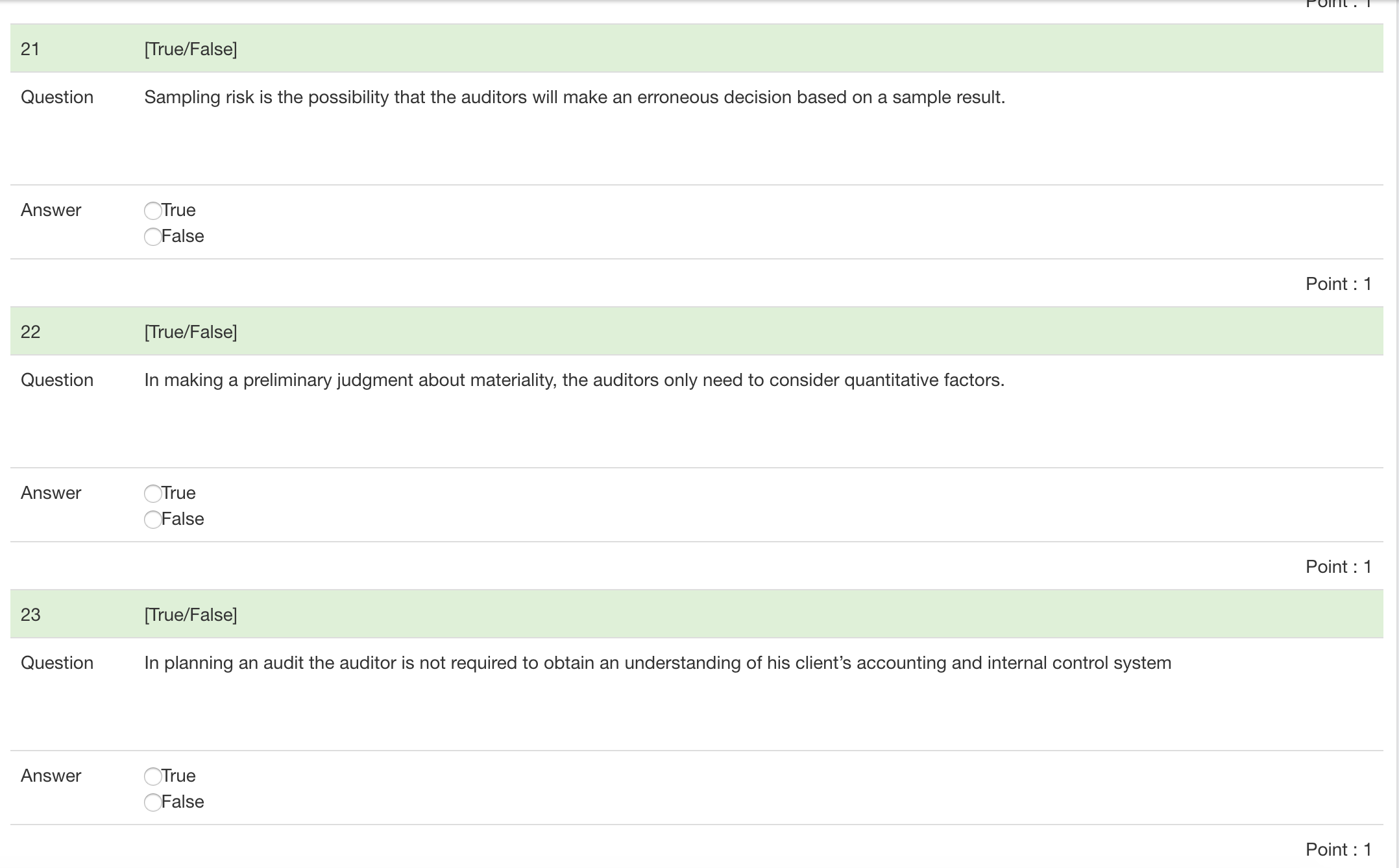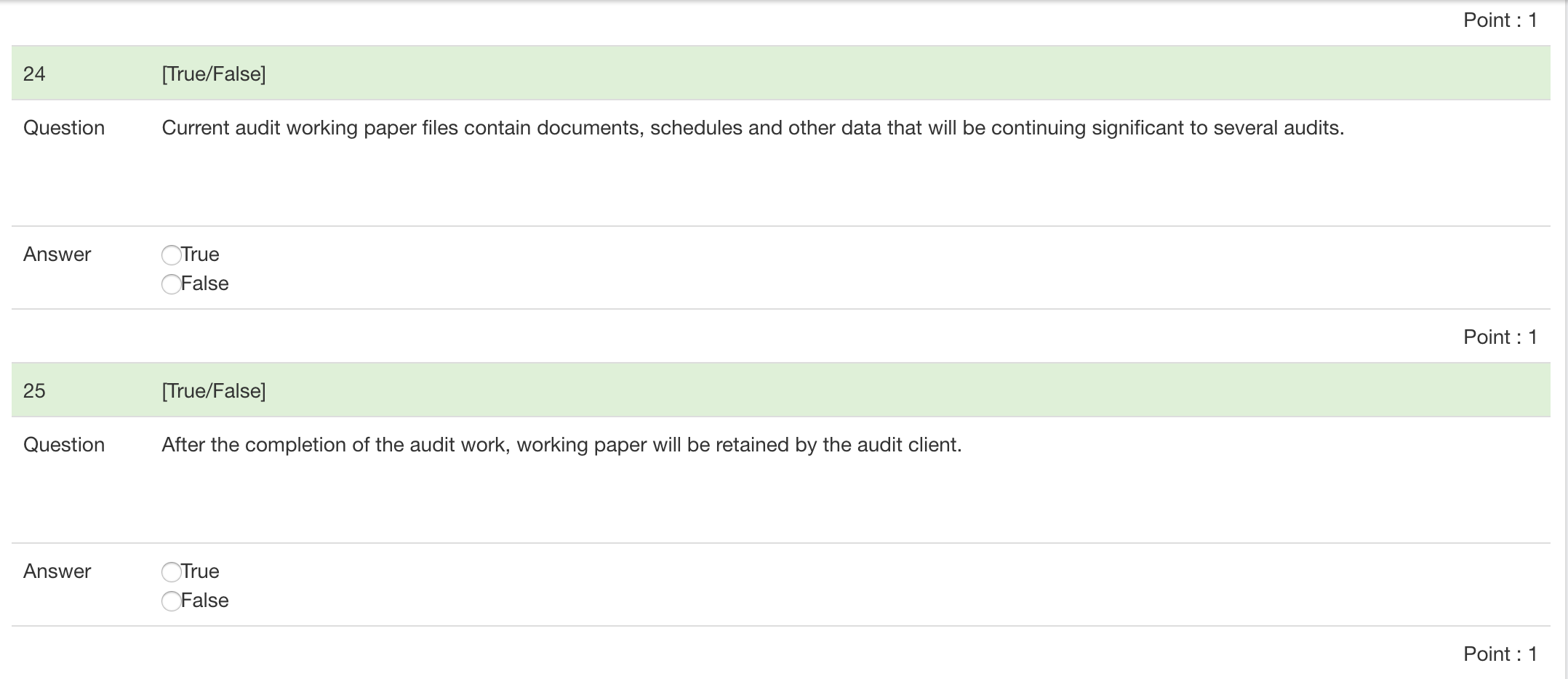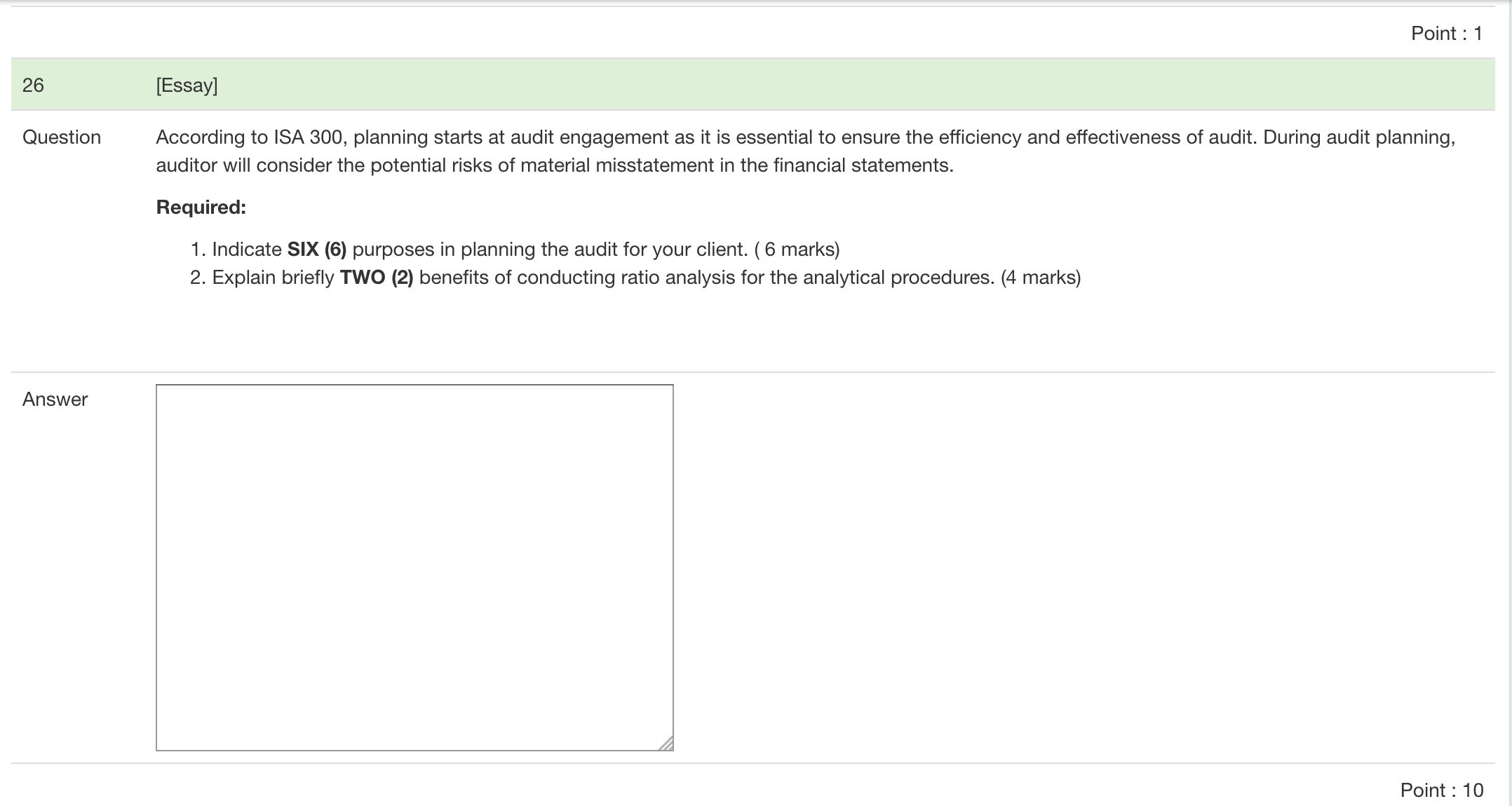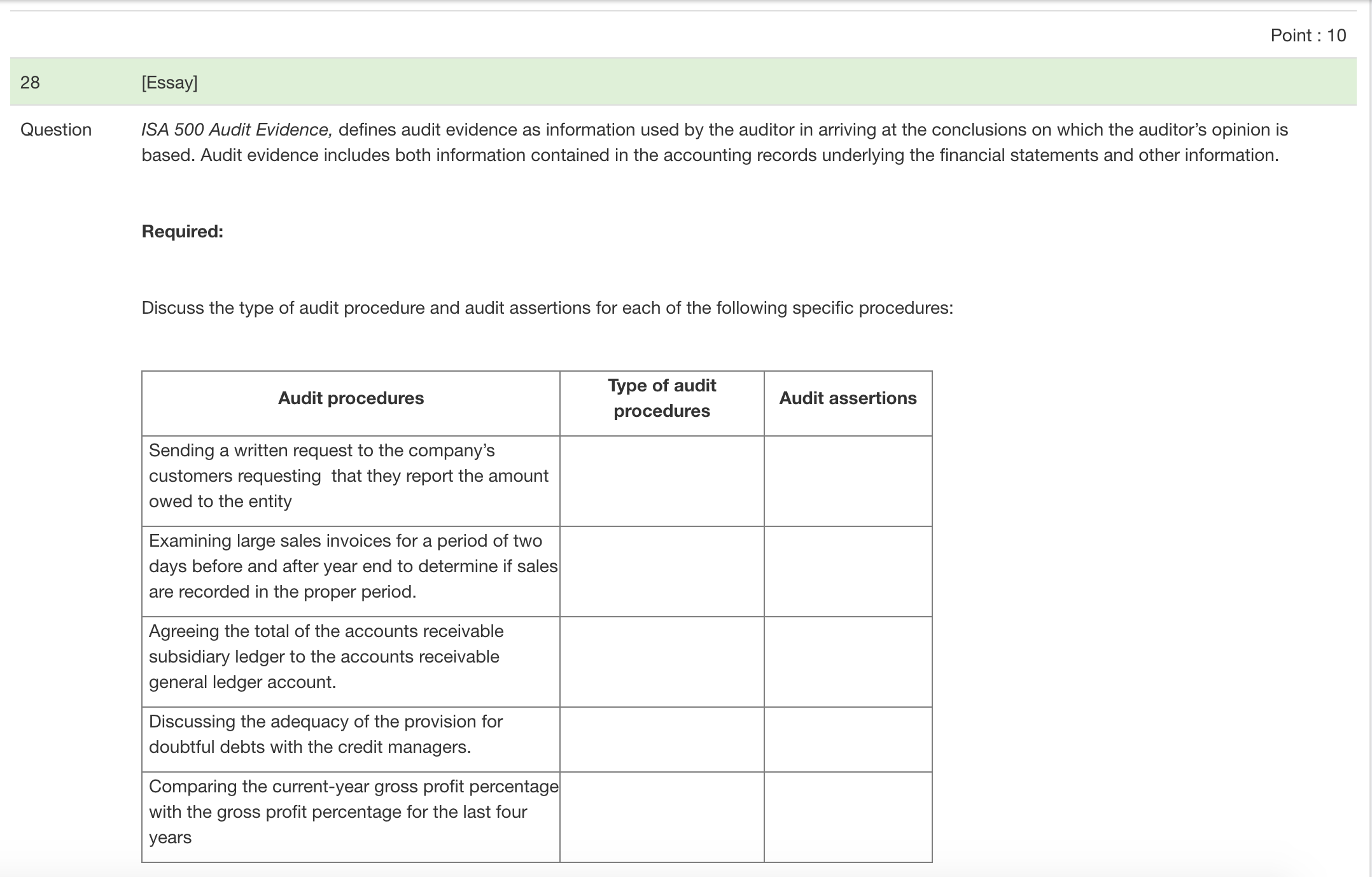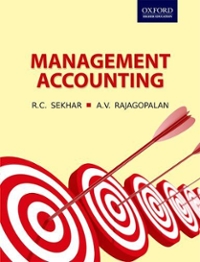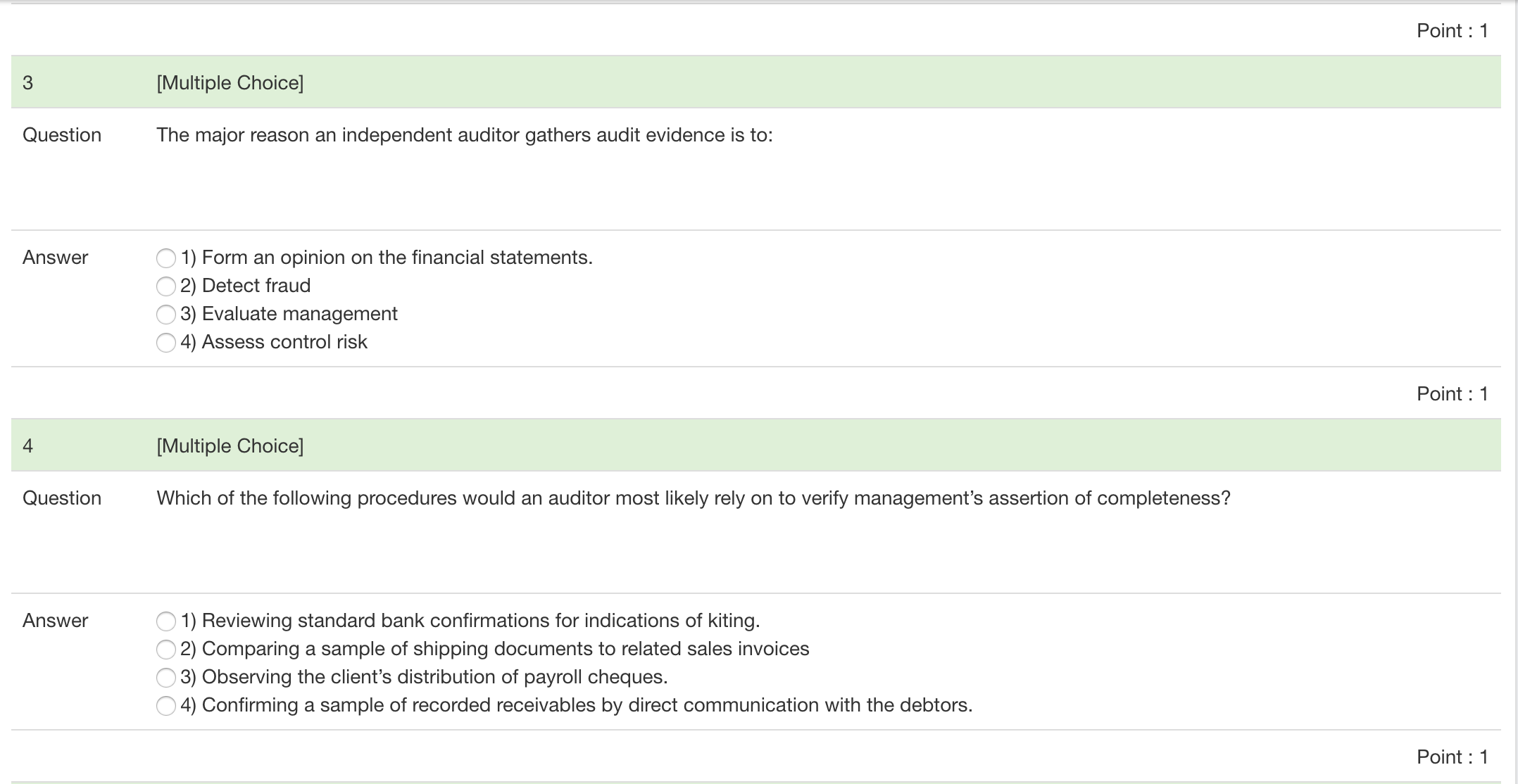
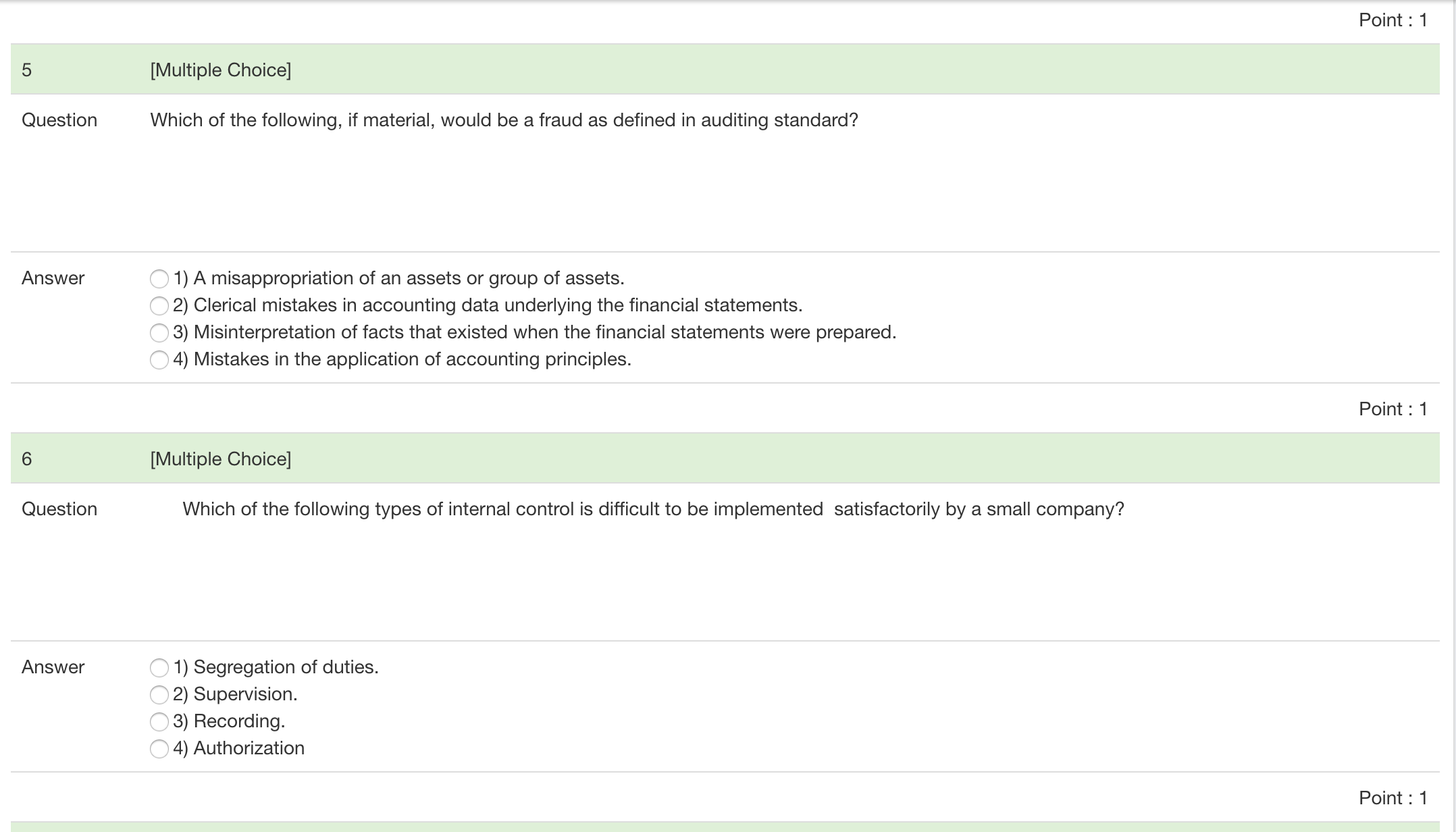
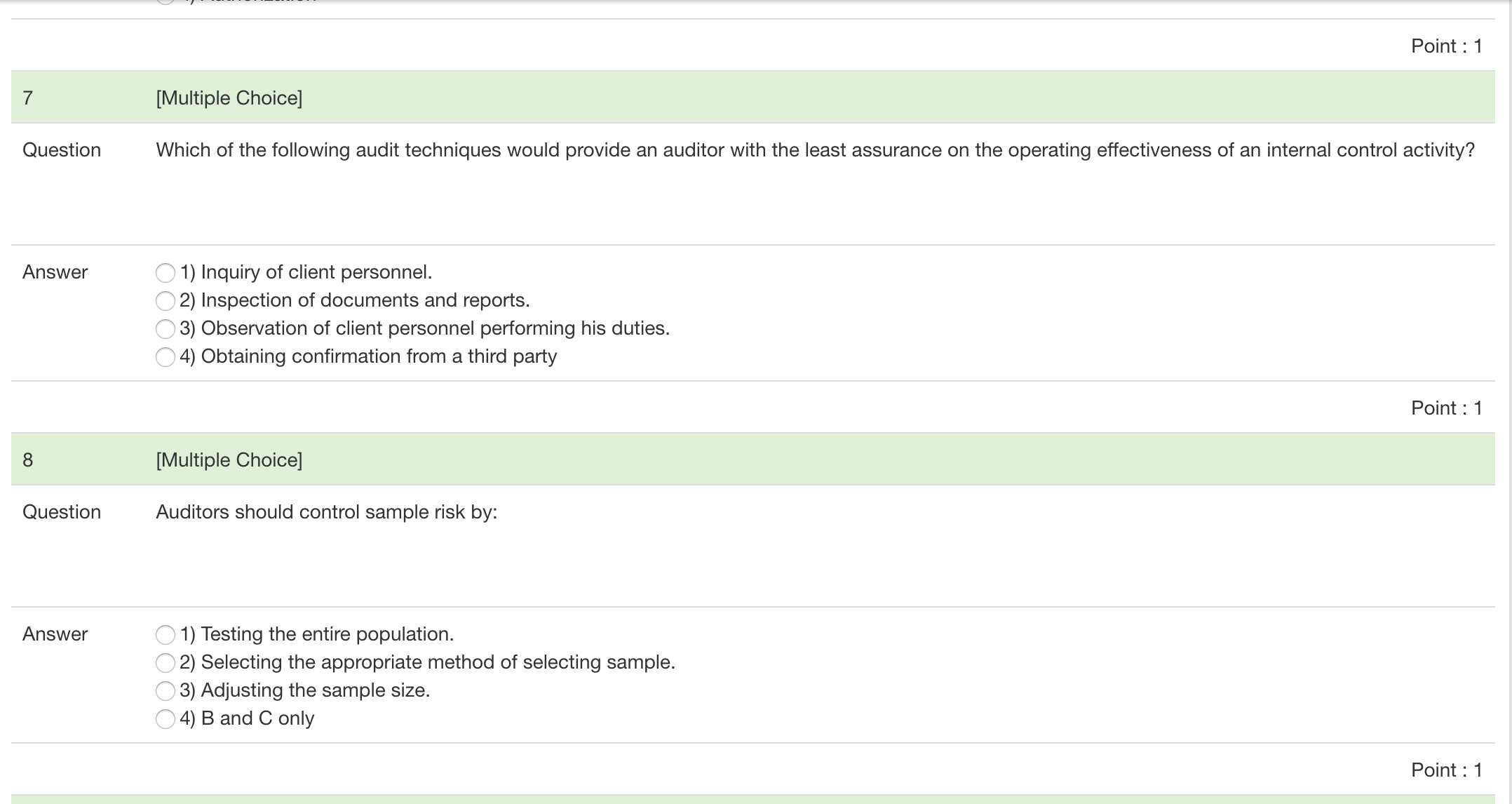
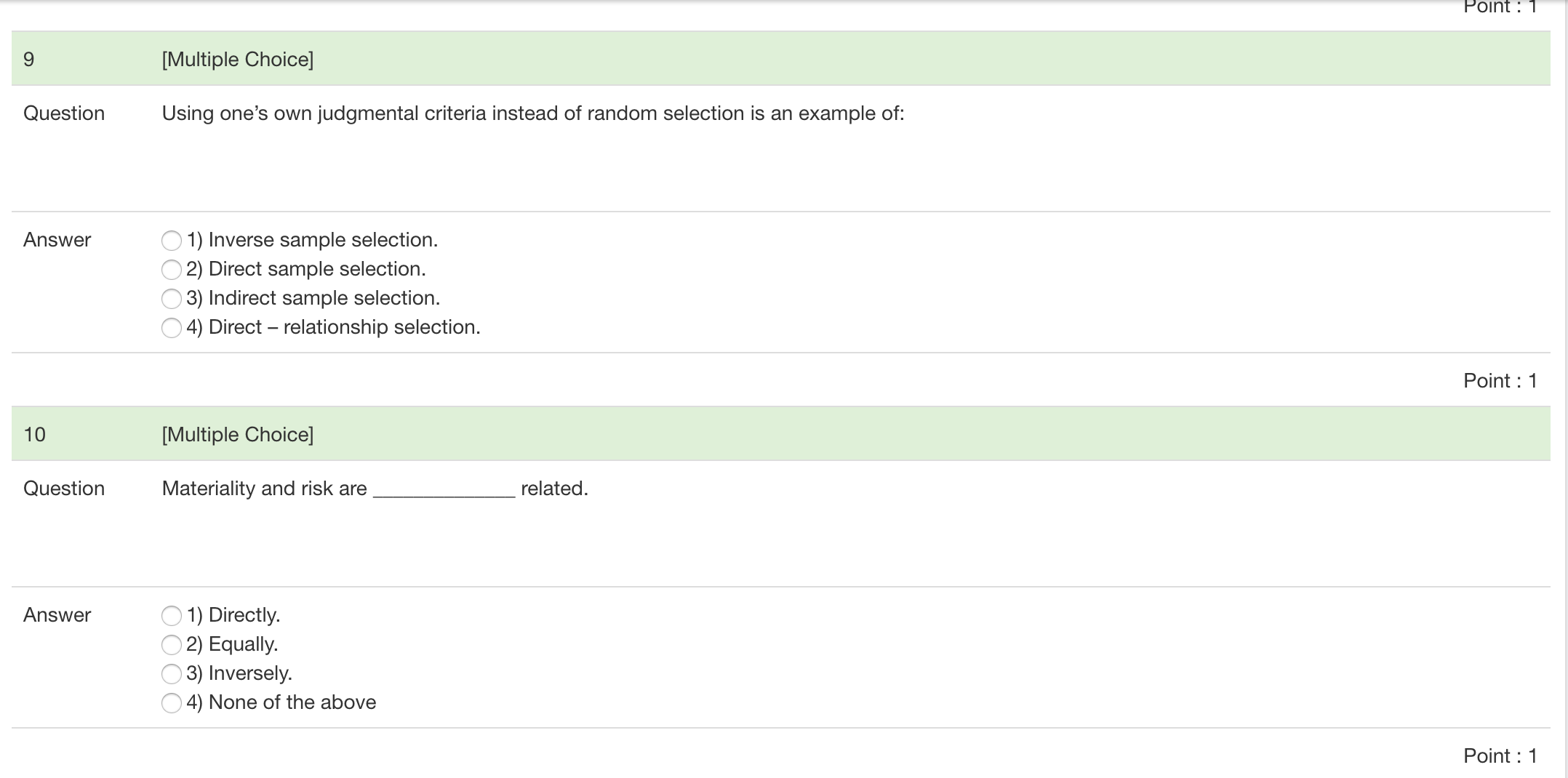
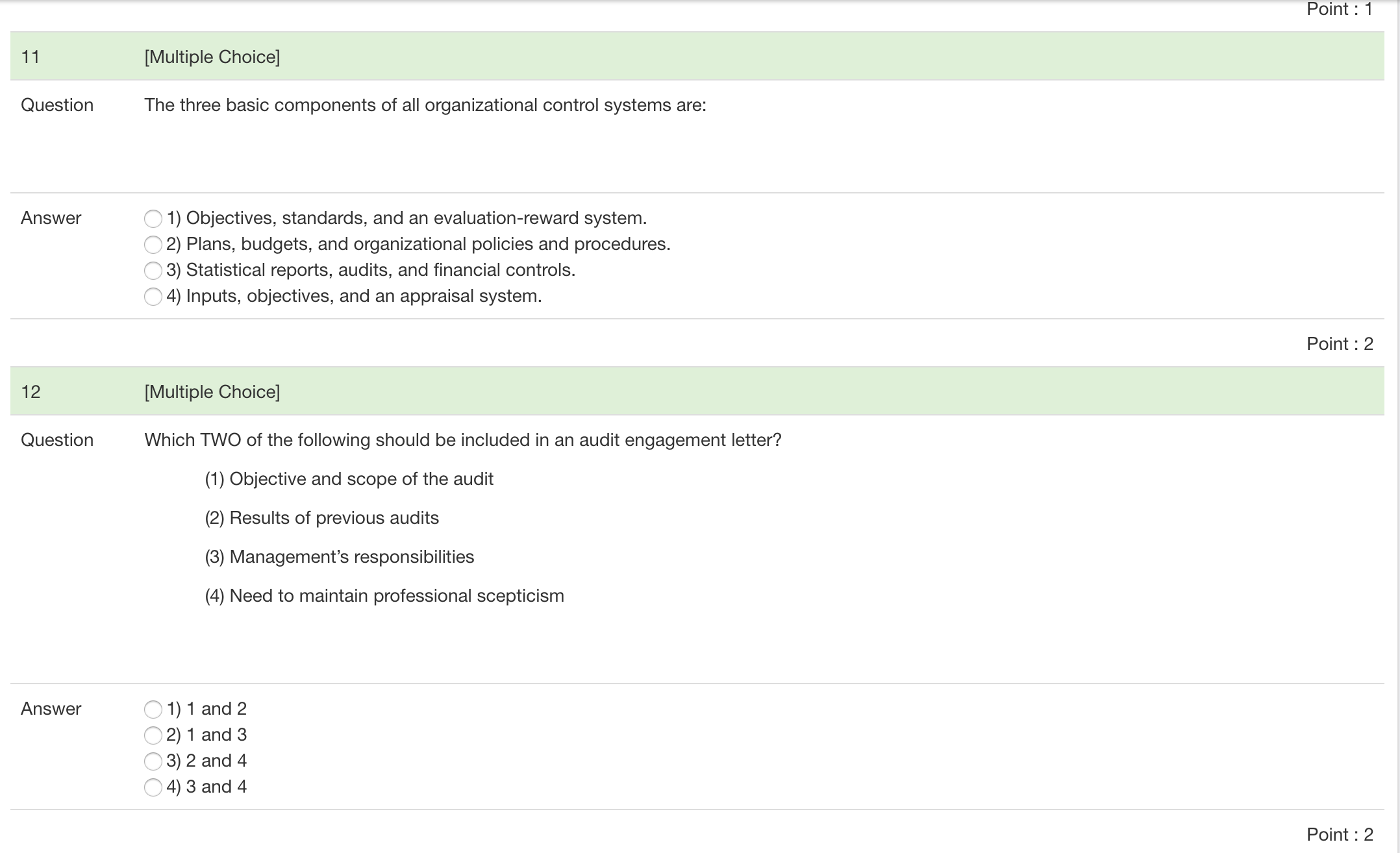
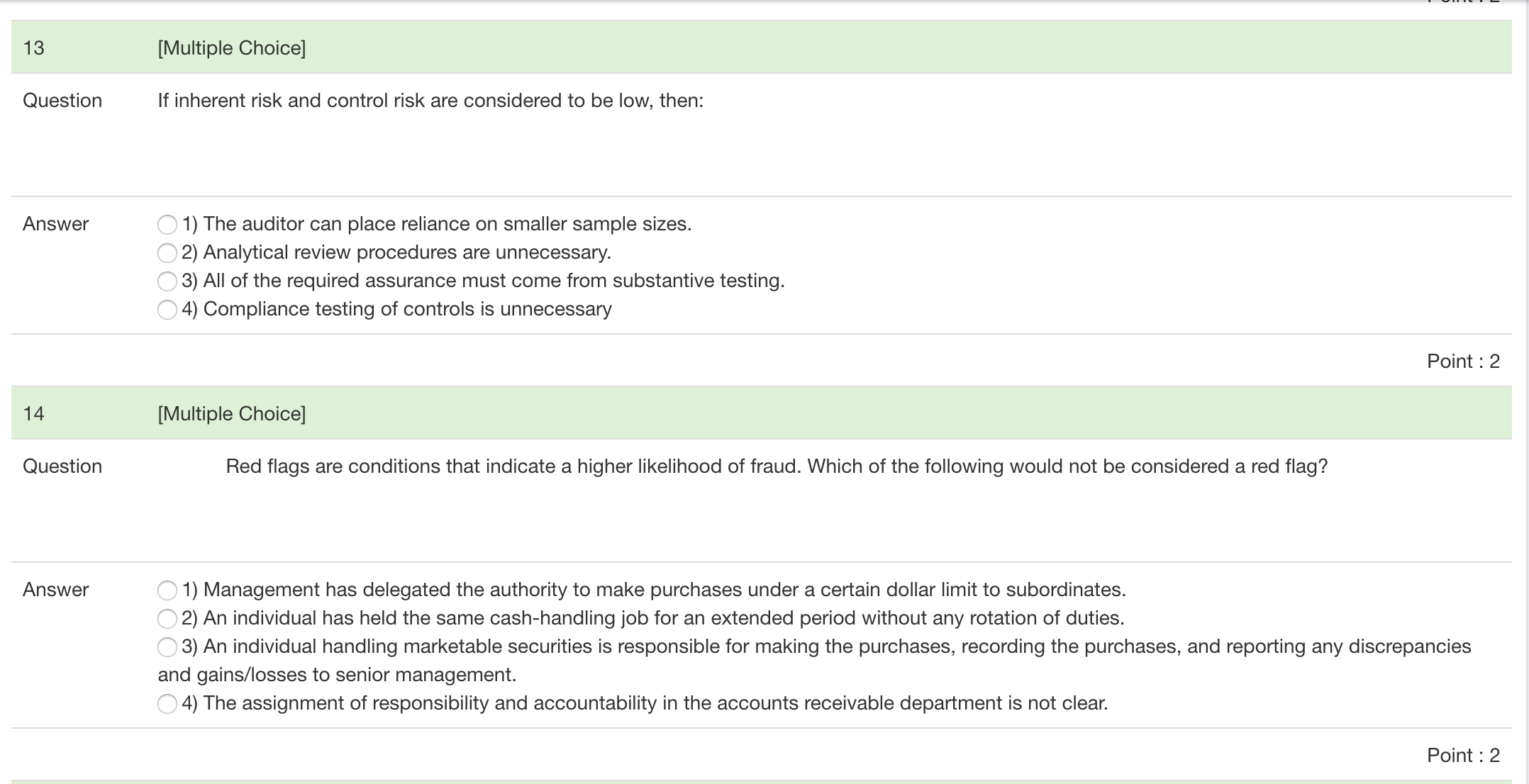
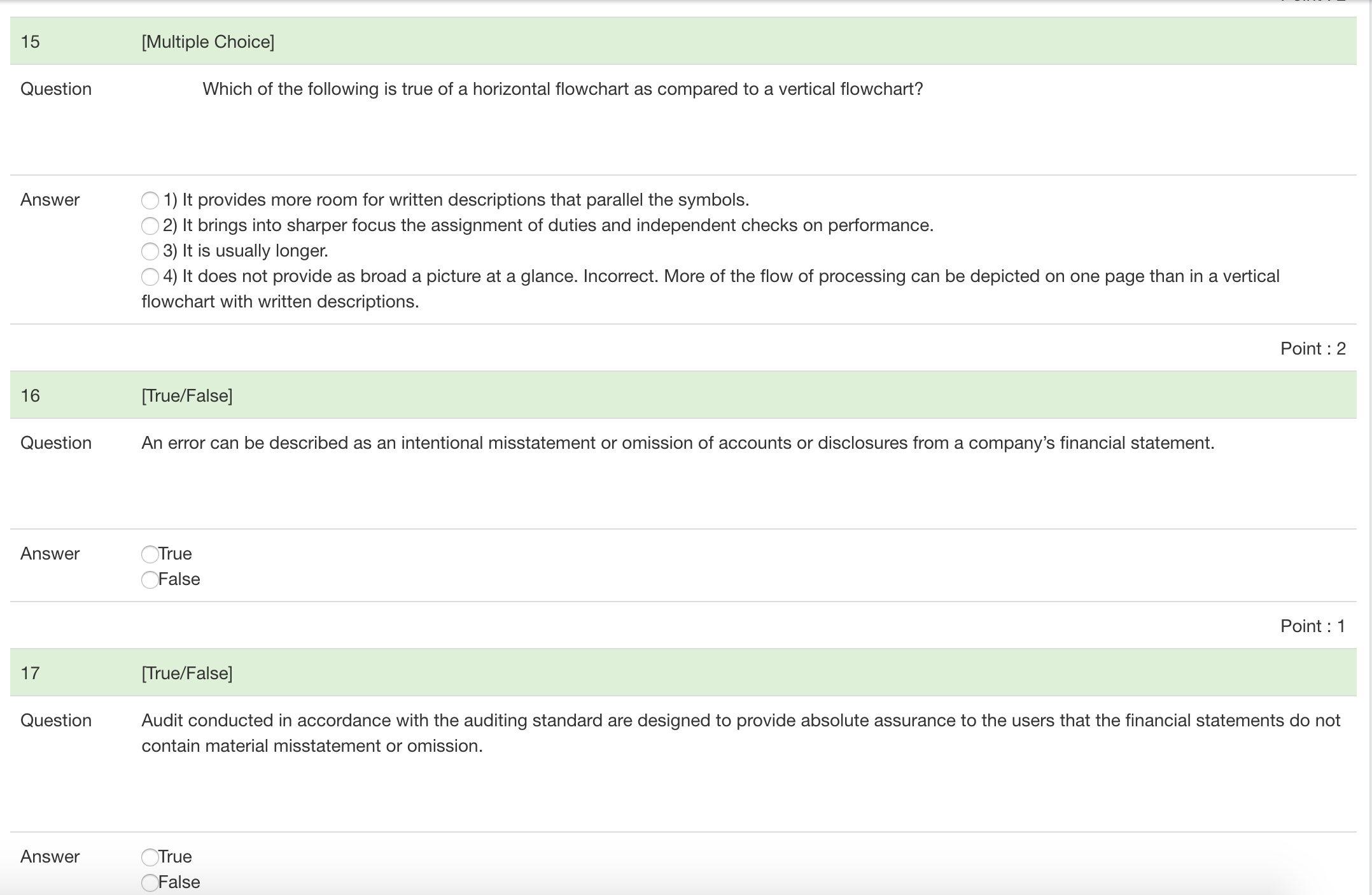
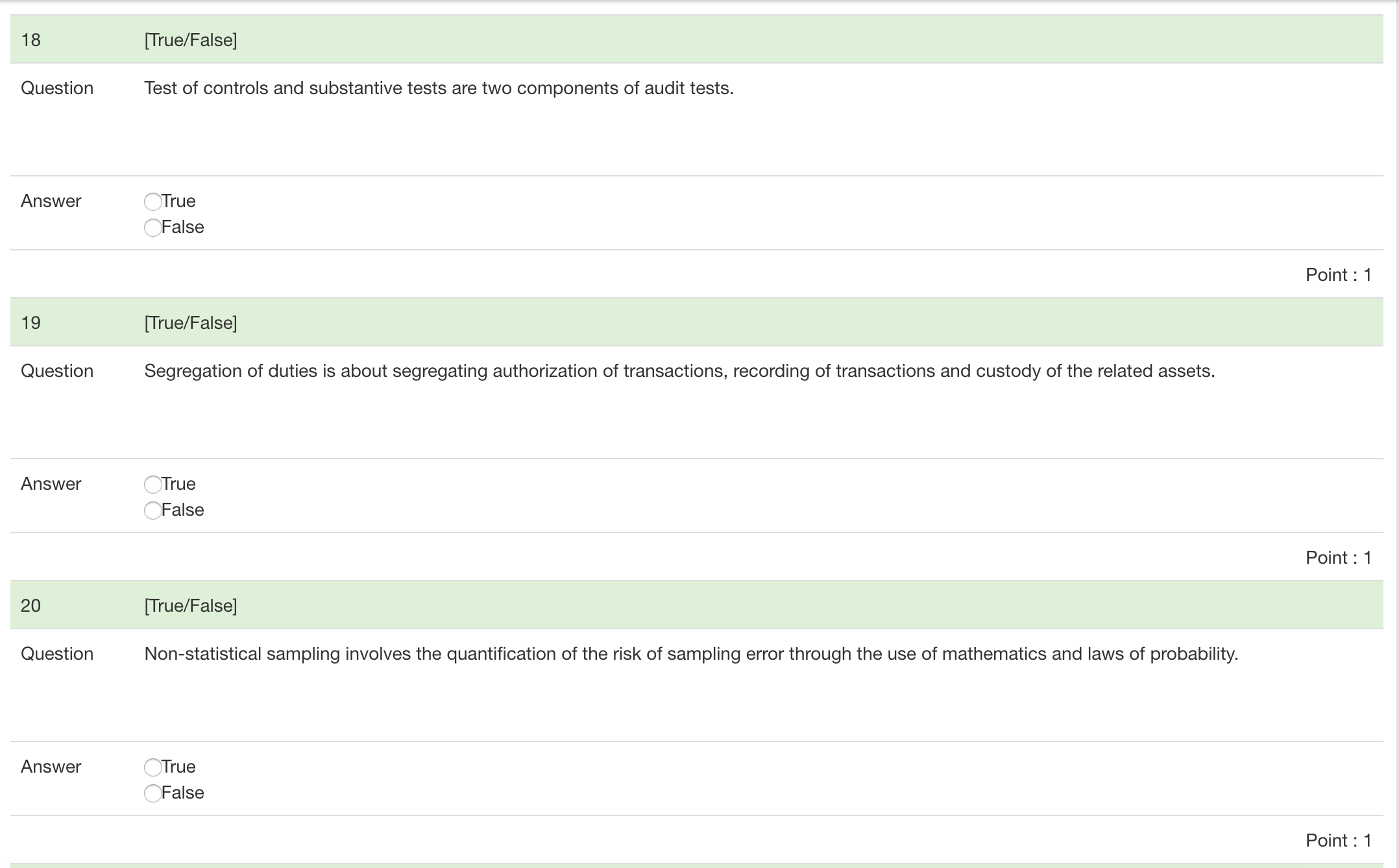
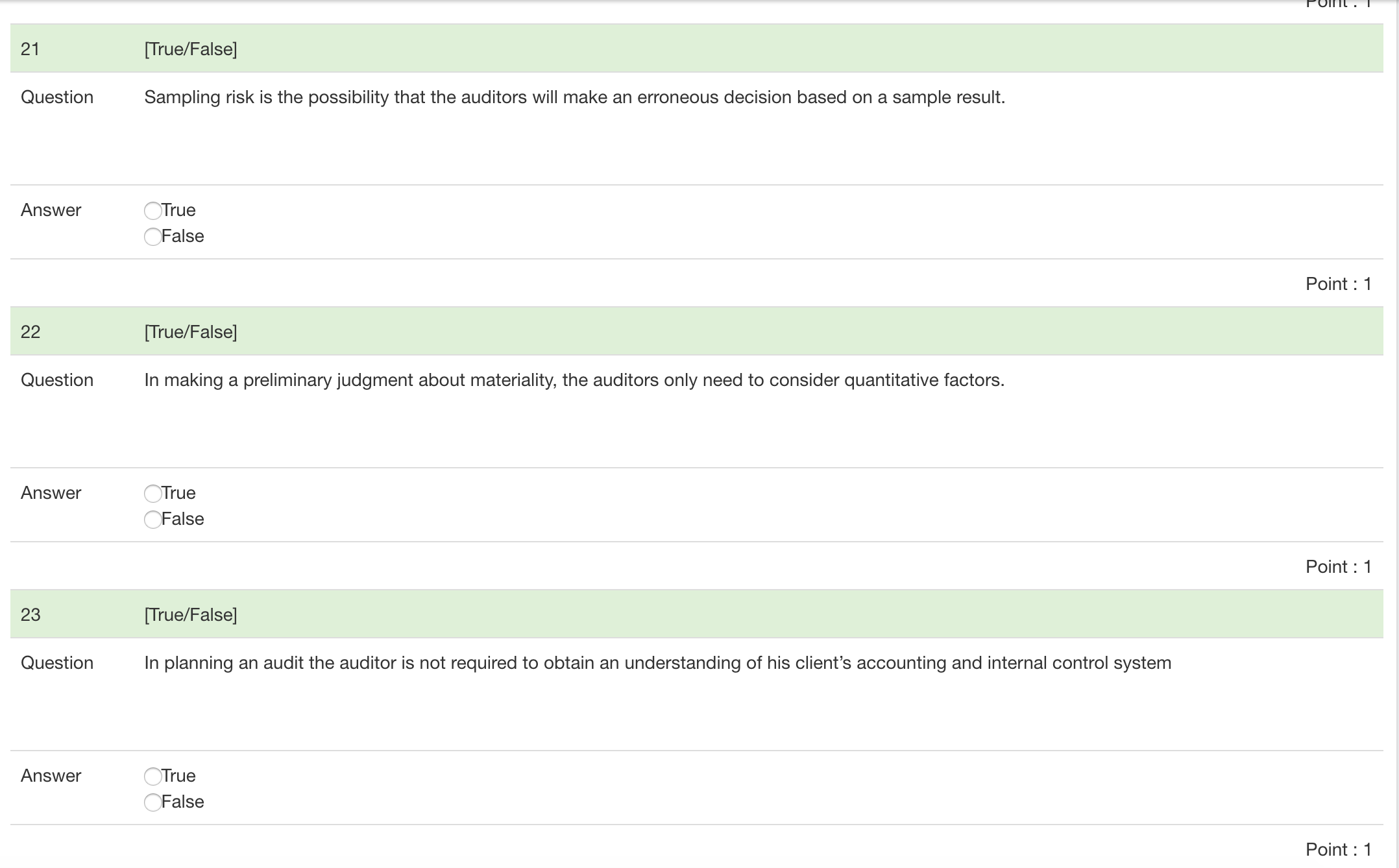
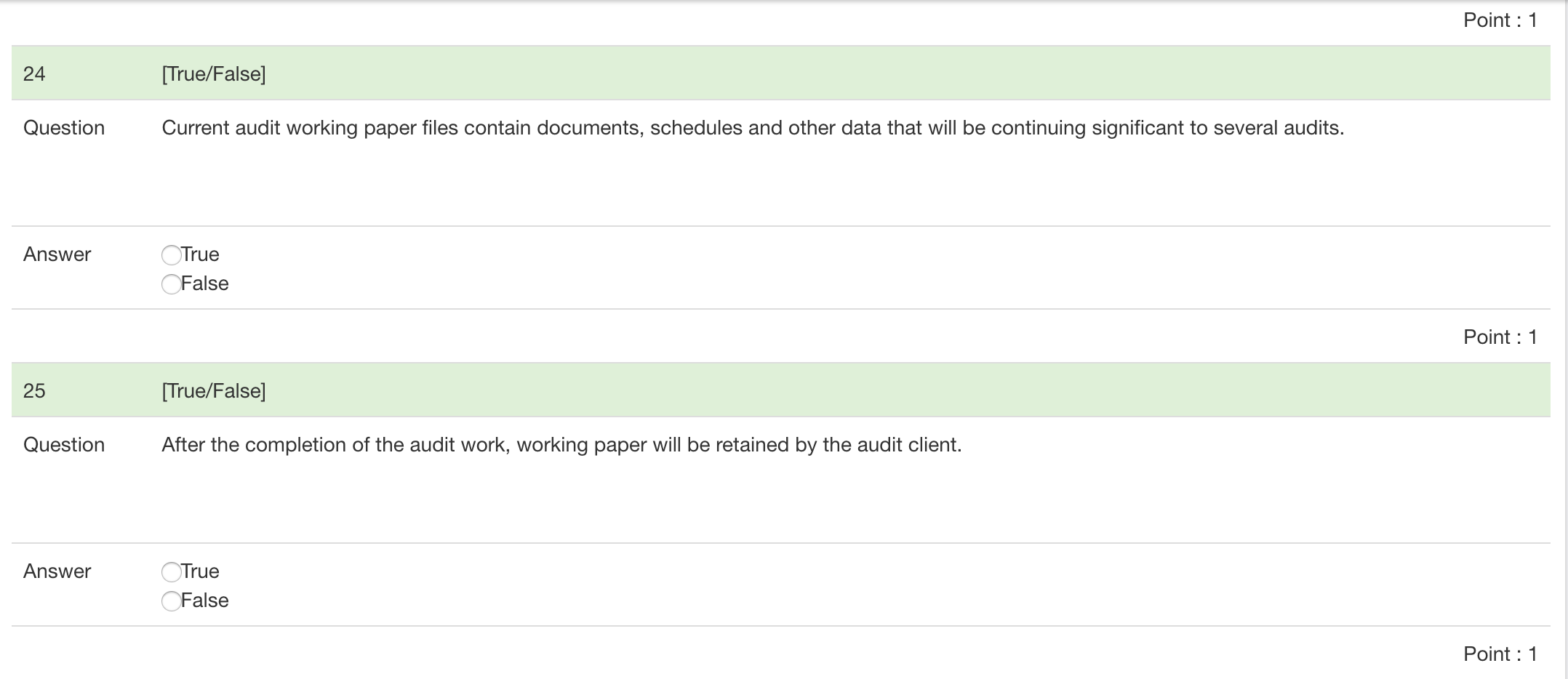
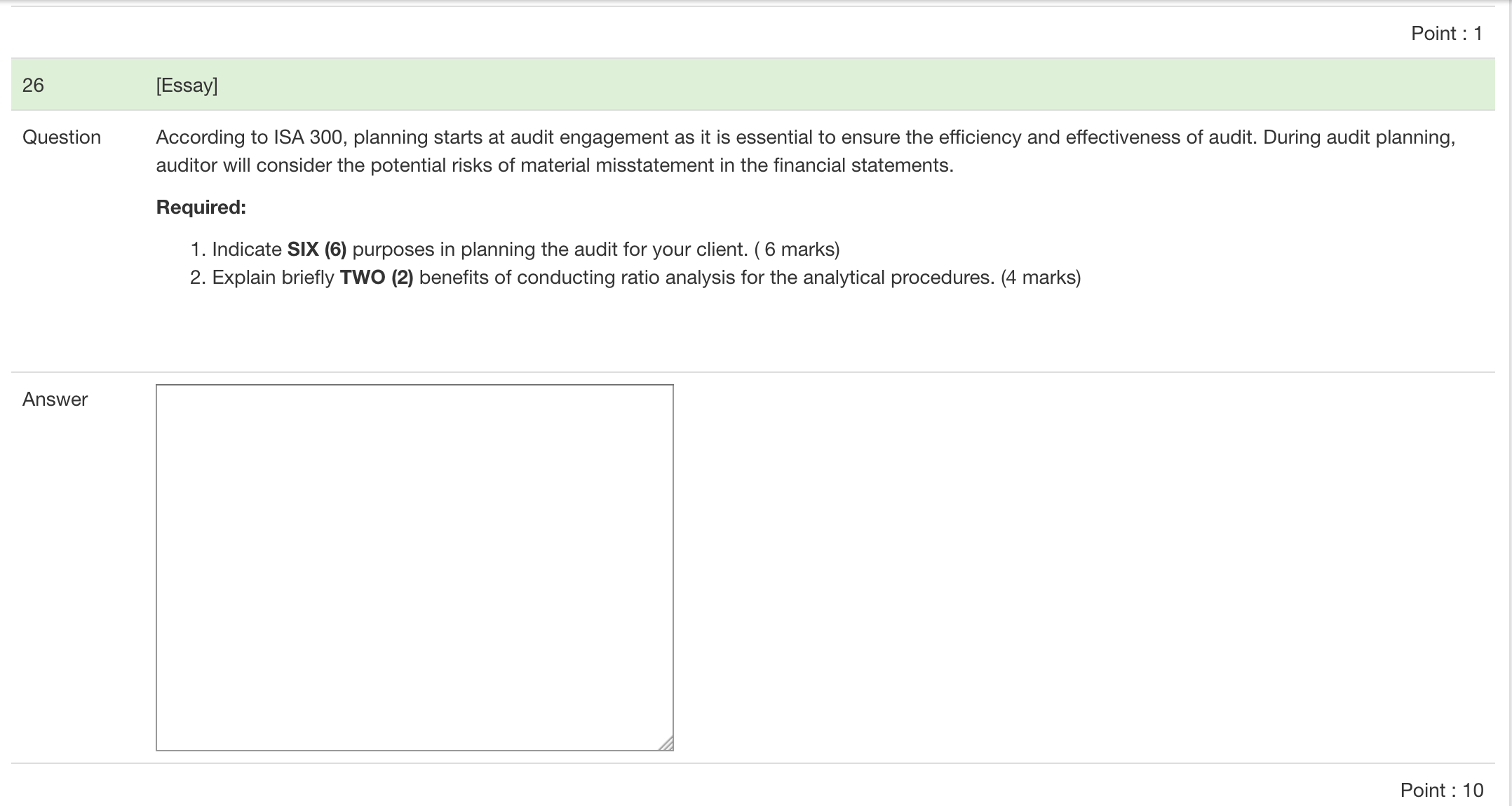
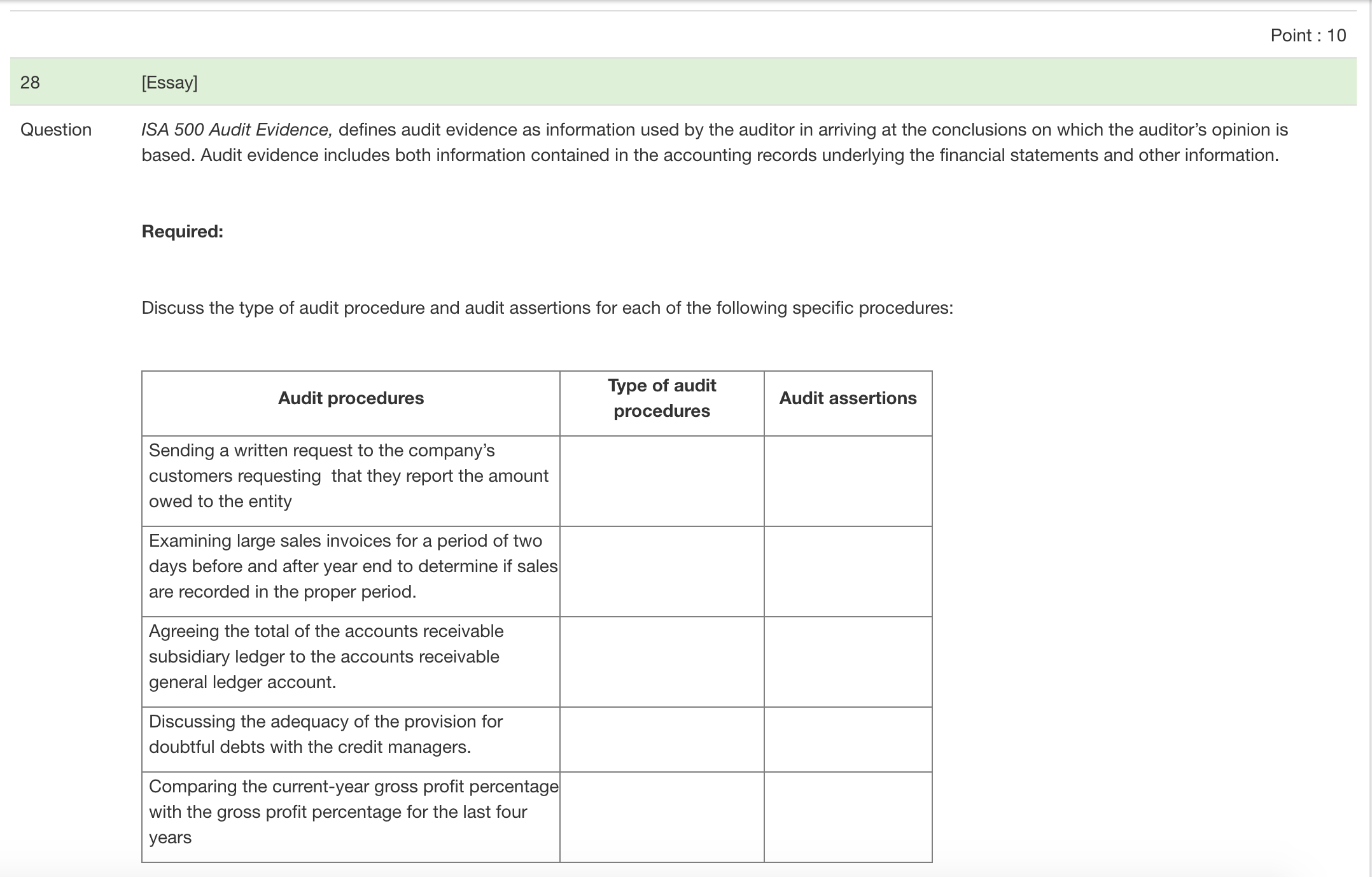
Question Question Answer 2 Question Answer [Multiple Answer] Identify which of the following financial information is least likely to be subjected to an independent audit of financial statements 01) 02) 03> 04) Statement of changes in equity. Statement of financial position. Statement of audit committee. Notes to the financial statement [Multiple Choice] An independent audit aids in the communication of economic data because the audit: 772) C73) Guarantees that financial data are fairly presented. Confirm the accuracy of management's financial representations. Lends credibility to the financial statements. Assures the readers of financial statements that any fraudulent activity has been corrected. Point : 1 Point : 1 Point : 1 3 [Multiple Choice] Question The major reason an independent auditor gathers audit evidence is to: Answer Form an opinion on the financial statements. A 2) Detect fraud A 3) Evaluate management A 4) Assess control risk Point : 1 4 [Multiple Choice] Question Which of the following procedures would an auditor most likely rely on to verify management's assertion of completeness? Answer A 1) Reviewing standard bank confirmations for indications of kiting. A 2) Comparing a sample of shipping documents to related sales invoices A 3) Observing the client's distribution of payroll cheques. A 4) Confirming a sample of recorded receivables by direct communication with the debtors. Point : 1 5 Question Answer 6 Question Answer [Multiple Choice] Which of the following, if material, would be a fraud as defined in auditing standard? :72) (713) A misappropriation of an assets or group of assets. Clerical mistakes in accounting data underlying the financial statements. Misinterpretation of facts that existed when the financial statements were prepared. Mistakes in the application of accounting principles. [Multiple Choice] Which of the following types of internal control is difficult to be implemented satisfactorily by a small company? 7.72) C3) Segregation of duties. Supervision. Recording. Authorization Point : 1 Point : 1 Point : 1 7 Question Answer 8 Question Answer [Multiple Choice] Point : 1 Which of the following audit techniques would provide an auditor with the least assurance on the operating effectiveness of an internal control activity? C71) C72) (723) ) ()4 Inquiry of client personnel. Inspection of documents and reports. Observation of client personnel performing his duties. Obtaining confirmation from a third party [Multiple Choice] Auditors should control sample risk by: 7.72) 03) Testing the entire population. Selecting the appropriate method of selecting sample. Adjusting the sample size. B and C only Point : 1 Point : 1 Question Using one's own judgmental criteria instead of random selection is an example of: Answer 0 1) Inverse sample selection. 0 2) Direct sample selection. 0 3) Indirect sample selection. 0 4) Direct relationship selection. Point : 1 Question Materiality and risk are related. Answer 0 1) Directly. O 2) Equally. O 3) lnversely. O 4) None of the above Point : 1 11 Question Answer 12 Question Answer [Multiple Choice] The three basic components of all organizational control systems are: \"1 (\\2 ()3 \"*4 ) ) ) ) Objectives, standards, and an evaluation-reward system. Plans, budgets, and organizational policies and procedures. Statistical reports, audits, and financial controls. Inputs, objectives, and an appraisal system. [Multiple Choice] Which TWO of the following should be included in an audit engagement letter? by'l by2 b3 (74 (1) Objective and scope of the audit (2) Results of previous audits (3) Management's responsibilities (4) Need to maintain professional scepticism 1and2 1and3 2and4 3and4 Point : 1 Point : 2 Point : 2 13 Question Answer 14 Question Answer [Multiple Choice] If inherent risk and control risk are considered to be low, then: A 1) The auditor can place reliance on smaller sample sizes. A 2) Analytical review procedures are unnecessary. A 3) All of the required assurance must come from substantive testing. A 4) Compliance testing of controls is unnecessary [Multiple Choice] Fled flags are conditions that indicate a higher likelihood of fraud. Which of the following would not be considered a red flag? A1) Management has delegated the authority to make purchases under a certain dollar limit to subordinates. A 2) An individual has held the same cash-handling job for an extended period without any rotation of duties. Point : 2 A 3) An individual handling marketable securities is responsible for making the purchases, recording the purchases, and reporting any discrepancies and gains/losses to senior management. A 4) The assignment of responsibility and accountability in the accounts receivable department is not clear. Point : 2 15 Question Answer 16 Question Answer 17 Question Answer [Multiple Choice] Which of the following is true of a horizontal flowchart as compared to a vertical flowchart? \"f 1) It provides more room for written descriptions that parallel the symbols. C 2) It brings into sharper focus the assignment of duties and independent checks on performance. \"7' 3) It is usually longer. O 4) It does not provide as broad a picture at a glance. Incorrect. More of the flow of processing can be depicted on one page than in a vertical flowchart with written descriptions. Point : 2 [True/False] An error can be described as an intentional misstatement or omission of accounts or disclosures from a company's financial statement. CTrue CFalse Point : 1 [True/False] Audit conducted in accordance with the auditing standard are designed to provide absolute assurance to the users that the financial statements do not contain material misstatement or omission. CTrue CFalse 18 [True/False] Question Test of controls and substantive tests are two components of audit tests. Answer OTrue OFalse Point : 1 19 [True/False] Question Segregation of duties is about segregating authorization of transactions, recording of transactions and custody of the related assets. Answer True OFalse Point : 1 20 [True/False] Question Non-statistical sampling involves the quantification of the risk of sampling error through the use of mathematics and laws of probability. Answer True False Point : 121 [True/False] Question Sampling risk is the possibility that the auditors will make an erroneous decision based on a sample result. Answer True OFalse Point : 1 22 [True/False] Question In making a preliminary judgment about materiality, the auditors only need to consider quantitative factors. Answer OTrue OFalse Point : 1 23 [True/False] Question In planning an audit the auditor is not required to obtain an understanding of his client's accounting and internal control system Answer True OFalse Point : 1Point : 1 24 [True/False] Question Current audit working paper files contain documents, schedules and other data that will be continuing significant to several audits. Answer True OFalse Point : 1 25 [True/False] Question After the completion of the audit work, working paper will be retained by the audit client. Answer True OFalse Point : 1Point : 1 26 [Essay] Question According to ISA 300, planning starts at audit engagement as it is essential to ensure the efficiency and effectiveness of audit. During audit planning, auditor will consider the potential risks of material misstatement in the financial statements. Required: 1. Indicate SIX (6) purposes in planning the audit for your client. (6 marks) 2. Explain briefly TWO (2) benefits of conducting ratio analysis for the analytical procedures. (4 marks) Answer Point : 10 28 Question [Essay] Point : 1O ISA 500 Audit Evidence, defines audit evidence as information used by the auditor in arriving at the conclusions on which the auditor's opinion is based. Audit evidence includes both information contained in the accounting records underlying the financial statements and other information. Required: Discuss the type of audit procedure and audit assertions for each of the following specific procedures: Audit procedures Type of audit procedures Audit assertions Sending a written request to the company's customers requesting that they report the amount owed to the entity Examining large sales invoices for a period of two days before and after year end to determine if sales are recorded in the proper period. Agreeing the total of the accounts receivable subsidiary ledger to the accounts receivable general ledger account. Discussing the adequacy of the provision for doubtful debts with the credit managers. Comparing the current-year gross profit percentage with the gross profit percentage for the last four years












